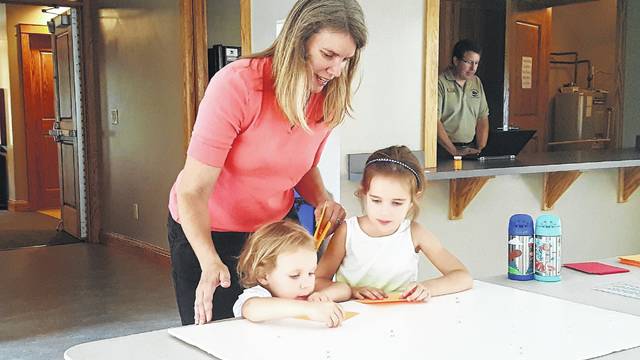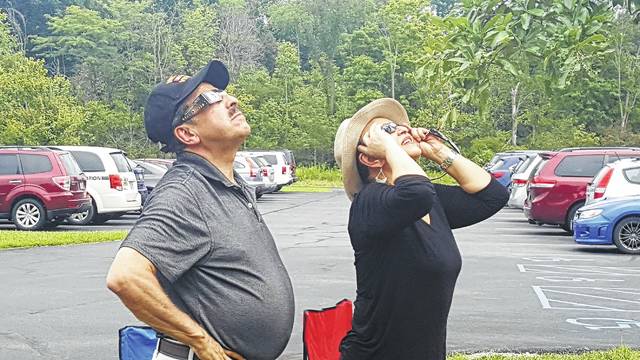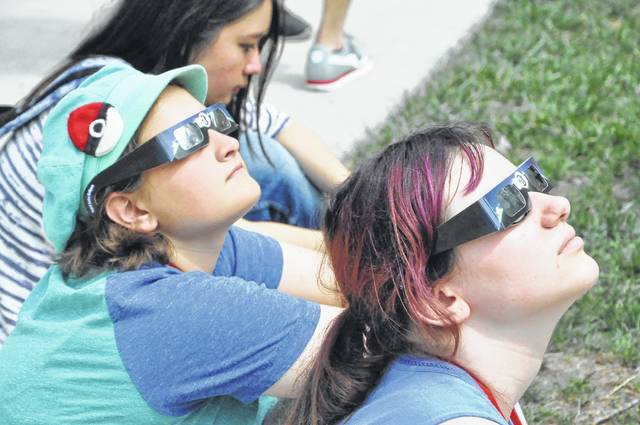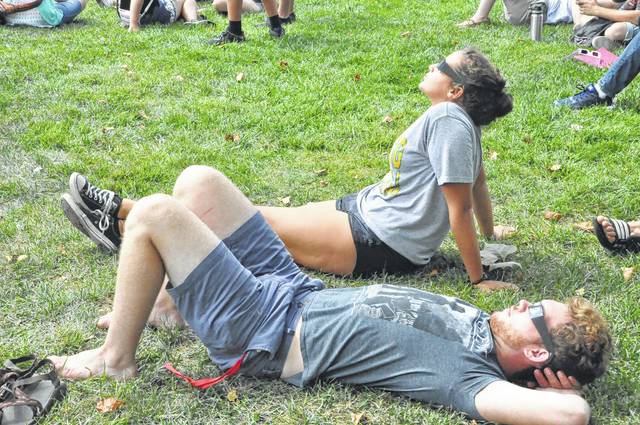



Central Ohio residents joined with millions of others across the United States to view a rare celestial occurrence on Monday.
For the first time in nearly a century, a total solar eclipse swept across the country. The shadow — a covering swath of land about 70 miles wide — came ashore in the vicinity of Lincoln City, Oregon at 1:16 p.m. EDT and pushed its way southeast through 14 states before exiting the U.S. at 2:47 p.m. near Charleston, South Carolina. Shawnee National Forest in southern Illinois was in line to see the longest stretch of darkness: 2 minutes and 44 seconds.
Preservation Parks of Delaware County hosted an eclipse-watch event at Deer Haven Park. Attendees took lawn chairs, blankets, and picnic lunches to the 97-acre park. Some just wanted to get their hands on the park district’s limited supply of special glasses to watch eclipse.
People lined up at 11 a.m., an hour before the 50 or so pairs of glasses were handed out to visitors, according to Deer Haven Park officials. The glasses were gone within two minutes after noon.
“It turned out not to be enough,” said Casey Smith, the naturalist in charge of the event.
Additionally, the park offered other ways to enjoy the eclipse. Kids had the chance to make “pinhole viewers.” A live feed of the eclipse from NASA was shown and pots and pans were provided “to scare the demons away” as some cultures did during the event, Smith said.
“I love that this is my job today,” she said.
Lisa Lape took her two daughters Katrina Lape, 5, and Jessica Lape, 3, to the park to make pinhole viewers. Their mother said they wanted to go “somewhere special to watch the eclipse.”
Bob Messerly of Powell said he remembered celebrating the eclipse with a pizza party when he taught astronomy at Westland High School. The 71-year-old retired teacher believes it will likely be his last chance to see the celestial event.
“I’ll go for this one and enjoy it,” he said.
Messerly was accompanied by his friends John and Carmen Cortez. The couple traveled from Hilliard to watch the event with him.
“For me, it’s a once in a lifetime,” John Cortez said.
Outside Merrick Hall on the Ohio Wesleyan University campus, hundreds of students gathered to watch the eclipse. The university played played solar-related music like “Eclipse” by Pink Floyd or “Ain’t No Sunshine” by Bill Withers and several professors were on hand with telescopes to give students a closer look at the eclipse.
“It’s really cool,” said Ashley Moen, a freshman. “It’s not something I thought I would be able to see, but then I saw it on the schedule and got excited.”
Moen said she’s even more excited for the next eclipse in 2024 because the path of totality will pass over her home outside Cleveland.
Freshman Jacob Van Atta said he enjoyed the eclipse and said it had an unexpected effect on him.
“It made me really hungry because it looked like a croissant,” Van Atta said with a laugh.
NASA reported 4.4 million people were watching its TV coverage midway through the eclipse, the biggest livestream event in the space agency’s history.
The Earth, moon and sun line up perfectly every one to three years, briefly turning day into night for a sliver of the planet. But these sights normally are in no man’s land, like the vast Pacific or Earth’s poles. This is the first eclipse of the social media era to pass through such a heavily populated area.
The moon hasn’t thrown this much shade at the U.S. since 1918, during the country’s last coast-to-coast total eclipse. In fact, the U.S. mainland hasn’t seen a total solar eclipse since 1979 — and even then, only five states in the Northwest experienced total darkness.
The next total solar eclipse in the U.S. will be in 2024. The next coast-to-coast one will not be until 2045.
.neFileBlock {
margin-bottom: 20px;
}
.neFileBlock p {
margin: 0px 0px 0px 0px;
}
.neFileBlock .neFile {
border-bottom: 1px dotted #aaa;
padding-bottom: 5px;
padding-top: 10px;
}
.neFileBlock .neCaption {
font-size: 85%;
}





